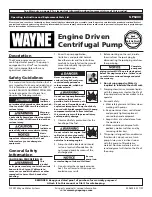
9
4.1. Important Information
Use only “C” version pumps where the pumping
of corrosive gases is involved.
The diaphragm and valves will suffer damage if
fluids are pumped over lengthy periods!
Before starting, ensure that impermissibly high
pressures cannot build up on the pressure side.
Interchanging the connections causes
dangerous excess pressure levels.
Do not start the pump if pressure difference
between inlet and outlet exceeds max. 1 bar.
Attemps to start pump at higher differential
pressure may cause the motor to jam and
damage may result.
4. Operations
Gas ballast valve 40
43 Top
X
Valve open
Y
Valve closed
43
4.2. Operation With Gas Ballast
Let the pump run with gas ballast to reduce condensation of
pumped substances (water vapour, solvents, ....) in the pump.
Opening the gas ballast valve
➡
Turn the top 43 of the gas ballast valve 40 to the position Y
(open).
With gas ballast valve open ultimate vacuum
will be reduced, pumping speed is decreased.
In case of low boiling solvents when the forma-
tion of condensate is unlikely, the use of gas
ballast might be unnecessary.
Operating the pump without gas ballast increa-
ses the solvent recovery rates at the exhaust waste vapour
condenser.
☞
PLEASE NOTE
Important notes regarding the use of gas ballast
Make sure that air/gas inlet through the gas
ballast valve never lead to hazardous, explo-
sive or otherwise dangerous mixtures. If in
doubt, use inert gas.
When using air rather than inert gas, risk of sig-
nificant damage to equipment and/or facilities,
risk of personal injury or even loss of life exists
due to the formation of hazardous and/or explo-
sive mixtures if air and pumped media react
inside or at the outlet of the pump.
Do not pump vapour before pump has reached
its operating temperature and with gas ballast
valve closed.
If the pump is subjected to condensates it
should be allowed to run for a few minutes
under atmospheric pressure before switching
off.
☞
PLEASE NOTE
DANGER
X
Y










































